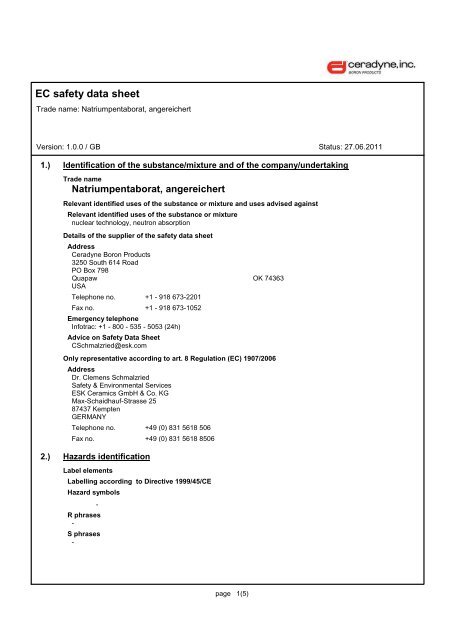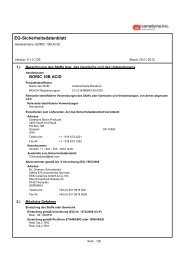Enriched Sodium Pentaborate - English SDS - Ceradyne Boron ...
Enriched Sodium Pentaborate - English SDS - Ceradyne Boron ...
Enriched Sodium Pentaborate - English SDS - Ceradyne Boron ...
Create successful ePaper yourself
Turn your PDF publications into a flip-book with our unique Google optimized e-Paper software.
EC safety data sheet<br />
Trade name: Natriumpentaborat, angereichert<br />
Version: 1.0.0 / GB<br />
1.) Identification of the substance/mixture and of the company/undertaking<br />
Trade name<br />
Natriumpentaborat, angereichert<br />
Relevant identified uses of the substance or mixture and uses advised against<br />
Relevant identified uses of the substance or mixture<br />
nuclear technology, neutron absorption<br />
Details of the supplier of the safety data sheet<br />
Address<br />
<strong>Ceradyne</strong> <strong>Boron</strong> Products<br />
3250 South 614 Road<br />
PO Box 798<br />
Quapaw OK 74363<br />
USA<br />
Telephone no. +1 - 918 673-2201<br />
Fax no. +1 - 918 673-1052<br />
Emergency telephone<br />
Infotrac: +1 - 800 - 535 - 5053 (24h)<br />
Advice on Safety Data Sheet<br />
CSchmalzried@esk.com<br />
Only representative according to art. 8 Regulation (EC) 1907/2006<br />
Address<br />
Dr. Clemens Schmalzried<br />
Safety & Environmental Services<br />
ESK Ceramics GmbH & Co. KG<br />
Max-Schaidhauf-Strasse 25<br />
87437 Kempten<br />
GERMANY<br />
Telephone no. +49 (0) 831 5618 506<br />
Fax no. +49 (0) 831 5618 8506<br />
2.) Hazards identification<br />
Label elements<br />
Labelling according to Directive 1999/45/CE<br />
Hazard symbols<br />
-<br />
R phrases<br />
-<br />
S phrases<br />
-<br />
page 1(5)<br />
Status: 27.06.2011
EC safety data sheet<br />
Trade name: Natriumpentaborat, angereichert<br />
Version: 1.0.0 / GB<br />
3.) Composition / information on ingredients<br />
Chemical characterization<br />
NaPB; B10-NaPB; B10 enriched NaPB<br />
Substance / product identification<br />
CAS no. 200443-98-7<br />
4.) First aid measures<br />
page 2(5)<br />
Status: 27.06.2011<br />
General information<br />
In all cases of doubt, or when sickness symptoms persist, seek medical attention. Remove contaminated clothing<br />
and shoes immediately, and launder thoroughly before reusing.<br />
After inhalation<br />
Remove affected person from the immediate area. Ensure supply of fresh air. In case of persisting adverse effects<br />
consult a physician.<br />
After skin contact<br />
Wash immediately with plenty of water for several minutes. Consult a doctor if skin irritation persists.<br />
After eye contact<br />
Separate eyelids, wash the eyes thoroughly with water (15 min.). Get medical attention if pain still persists.<br />
After ingestion<br />
Call in a physician immediately and show him the Safety Data Sheet. Do not induce vomiting. Rinse mouth<br />
thoroughly with water. Never give anything by mouth to an unconscious person.<br />
5.) Fire-fighting measures<br />
Suitable extinguishing media<br />
Water spray jet; Carbon dioxide; Foam; Dry chemicals<br />
Special exposure hazards arising from the substance or preparation itself, combustion products, resulting<br />
gases<br />
In case of combustion evolution of dangerous gases possible. In the event of fire, the following can be released:<br />
<strong>Boron</strong> oxides<br />
Special protective equipment for fire-fighters<br />
Use self-contained breathing apparatus. Wear protective clothing.<br />
Other information<br />
Cool endangered containers with water spray jet.<br />
6.) Accidental release measures<br />
Personal precautions<br />
Refer to protective measures listed in sections 7 and 8. Ensure adequate ventilation. Avoid dust formation.<br />
Environmental precautions<br />
Do not discharge into the drains/surface waters/groundwater.<br />
Methods for cleaning up/taking up<br />
Take up mechanically. Clean contaminated surfaces thoroughly with water and soap. Send in suitable containers for<br />
recovery or disposal.
EC safety data sheet<br />
Trade name: Natriumpentaborat, angereichert<br />
Version: 1.0.0 / GB<br />
7.) Handling and storage<br />
Handling<br />
page 3(5)<br />
Status: 27.06.2011<br />
Advice on safe handling<br />
Product inherent handling risks must be minimised taking the appropriate measures for protection and preventive<br />
actions. The working process should be designed to rule out the release of hazardous substances or skin contact as<br />
far it is possible by the state of the art. Provide good ventilation of working area (local exhaust ventilation, if<br />
necessary). Avoid the formation and deposition of dust.<br />
Advice on protection against fire and explosion<br />
Keep away from sources of heat and ignition. Take precautionary measures against static charges. Avoid formation<br />
of dust.<br />
Storage<br />
Requirements for storage rooms and vessels<br />
Containers which are opened must be carefully resealed and kept upright to prevent leakage. Always keep in<br />
containers of same material as the original one.<br />
Advice on storage assembly<br />
Do not store together with: Oxidizing agents; Acids; corrosives<br />
Further information on storage conditions<br />
Keep container tightly closed and dry in a cool, well-ventilated place. Protect from heat and direct sunlight.<br />
8.) Exposure controls / personal protection<br />
Exposure limit values<br />
DUST<br />
List of approved workplace exposure limits (WELs) / EH40<br />
total inhalable dust<br />
TWA 10 mg/m³<br />
List of approved workplace exposure limits (WELs) / EH40<br />
respirable dust<br />
TWA 4 mg/m³<br />
Exposure controls<br />
Personal protective equipment<br />
Respiratory protection<br />
If workplace exposure limits are exceeded, a respiration protection approved for this particular job must be worn. In<br />
case of dust formation, take appropriate measures for breathing protection in the event workplace threshold values<br />
are not specified.<br />
Hand protection<br />
Sufficient protection is given wearing suitable protective gloves checked according to i.e. EN 374, in the event of risk<br />
of skin contact with the product . Before use, the protective glove should be tested in any case for its specific<br />
work-station suitability (i.e. mechanical resistance, product compatibility and antistatic properties). Adhere to the<br />
manufacturer’s instructions and information relating to the use, storage, care and replacement of protective gloves.<br />
Protective gloves shall be replaced immediately when physically damaged or worn. Design operations thus to avoid<br />
permanent use of protective gloves.<br />
Eye protection<br />
Safety glasses with side protection shield (EN 166)<br />
Skin protection<br />
Normal chemical work clothing.
EC safety data sheet<br />
Trade name: Natriumpentaborat, angereichert<br />
Version: 1.0.0 / GB<br />
page 4(5)<br />
Status: 27.06.2011<br />
General protective and hygiene measures<br />
Do not eat, drink or smoke during work time. Keep away from foodstuffs and beverages. Wash hands before breaks<br />
and after work. Do not inhale dust. Store work clothing separately. Remove soiled or soaked clothing immediately.<br />
Avoid contact with eyes and skin.<br />
9.) Physical and chemical properties<br />
General information<br />
Form Powder<br />
Colour white<br />
Odour odourless<br />
Important health, safety and environmental information<br />
Changes in physical state<br />
Type Boiling point<br />
Remarks not determined<br />
Type Melting point<br />
Remarks not determined<br />
Flash point<br />
Remarks not applicable<br />
Ignition temperature<br />
Remarks not applicable<br />
Explosion limits<br />
Remarks not applicable<br />
Density<br />
Value 1,72 g/cm³<br />
Solubility in water<br />
Value 15,4 %<br />
10.) Stability and reactivity<br />
Conditions to avoid<br />
None, if handled according to order.<br />
Materials to avoid<br />
Oxidizing agents; strong acids; highly corrosive substances<br />
Hazardous decomposition products<br />
Toxic gases/vapours; <strong>Boron</strong> oxides<br />
Thermal decomposition<br />
Remarks No decomposition if used as prescribed.<br />
11.) Toxicological information<br />
Experience in practice<br />
Eye contact with the product may lead to irritation. Irritating effects on skin is possible. Inhalation may lead to<br />
irritation of the respiratory tract.<br />
Other information<br />
Product specific toxicological data are not known.
EC safety data sheet<br />
Trade name: Natriumpentaborat, angereichert<br />
Version: 1.0.0 / GB<br />
12.) Ecological information<br />
page 5(5)<br />
Status: 27.06.2011<br />
Other information<br />
Do not discharge product unmonitored into the environment. Ecological data are not available.<br />
13.) Disposal considerations<br />
Product<br />
Allocation of a waste code number, according to the European Waste Catalogue, should be carried out in agreement<br />
with the regional waste disposal company.<br />
Packaging<br />
Contaminated packaging should be emptied as far as possible and after appropriate cleansing may be taken for<br />
reuse. Packaging that cannot be cleaned should be disposed of in agreement with the regional waste disposal<br />
company.<br />
14.) Transport information<br />
Other information<br />
The product is not defined under national/international road, rail, sea and air transport regulations as a hazardous<br />
material.<br />
15.) Regulatory information<br />
Safety, health and environmental regulations/legislation specific for the substance or mixture<br />
EU regulations<br />
Restriction of occupation<br />
Adhere to the national regulations when using this product.<br />
Council Directive 96/82/EC on the control of major-accident hazards involving dangerous substances<br />
Remarks Annex I, part 1 + 2: not mentioned. With regard to possibly appropriate<br />
decomposition products see Chapter 10.<br />
16.) Other information<br />
Sources of key data used to compile the data sheet:<br />
EC Directive 67/548/EC resp. 99/45/EC as amended in each case.<br />
Regulation (EC) No 1907/2006 (REACH), 1272/2008 (CLP) as amended in each case.<br />
EC Directives 2000/39/EC, 2006/15/EC, 2009/161/EC<br />
National Threshold Limit Values of the corresponding countries as amended in each case.<br />
Transport regulations according to ADR, RID, IMDG, IATA as amended in each case.<br />
The data sources used to determine physical, toxic and ecotoxic data, are indicated directly in the corresponding<br />
chapter.<br />
Department issuing safety data sheet<br />
UMCO Umwelt Consult GmbH<br />
Georg-Wilhelm-Str. 183 , D-21107 Hamburg<br />
Tel.: +49 40 / 79 02 36 300 Fax: +49 40 / 79 02 36 357 e-mail: umco@umco.de<br />
This information is based on our present state of knowledge. However, it should not constitute a guarantee for any<br />
specific product properties and shall not establish a legally valid relationship.




